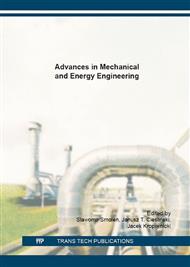p.63
p.71
p.83
p.92
p.104
p.112
p.117
p.126
p.144
Experimental Investigation on the Impact of Distorted Signal on Synthetic Jet
Abstract:
Effective techniques for cooling electronic devices must deal with increasing heat loads associated with higher heat flux density. Many conventional cooling techniques like fan are reaching the limits of their effectiveness and shape. The novel method of heat transfer enhancement is synthetic jet. In this paper experimental results are presented. Synthetic jet actuator consist of STX 6.5 inch speaker installed in metacrylate chamber with circular orifice. The actuator was powered with signal from amplifier. The signal consist of basic sinusoidal function and THD noise added with some amplitude. The root mean square of signal voltage was constant 4V. The properties of synthetic jet were measured using constant temperature thermo-anemometer. Instantaneous velocity of air was measured in the orifice center and compared with input signal. Additional RMS and average velocity of air were measured. Measurement revealed that input signal of synthetic jet generator can contain some noise without effect on RMS and average velocity of air in the orifice. The THD less than 1% does not cause negative effect on synthetic jet fluid velocity.
Info:
Periodical:
Pages:
104-111
Citation:
Online since:
April 2016
Authors:
Price:
Сopyright:
© 2016 Trans Tech Publications Ltd. All Rights Reserved
Share:
Citation:


